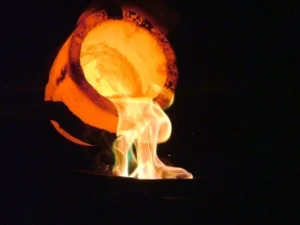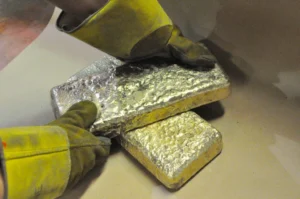If you’re interested in precious metals, you may already know that items like jewelry, silverware and even dental implants are often refined to extract gold, silver, platinum and palladium. But what exactly is refining, and how does it work, and why is it important?
In a nutshell, precious metals refining is the process of extracting and purifying valuable metals from various materials. Common sources of scrap include jewelry, dental materials like crowns and fillings, household items such as flatware, buttons, and pins. Other less obvious sources include electronic components, automotive parts, and medical implants. Through refining, these items are processed to isolate the precious metals and return them to a pure, reusable state.

Why Should Precious Metals Be Refined?
Refining removes impurities such as metals and organic residues, isolating only the precious metal content. This is achieved by melting the materials and using a flux to help separate impurities from the precious metals. Refineries like Garfield specialize in this process, efficiently recovering valuable metals while supporting a sustainable supply chain of recycled resources.
Refining is Recycling
Precious metal refining is essentially a specialized form of recycling that requires advanced equipment and techniques to achieve the highest purity levels. Metals like gold, silver, platinum and palladium can be recycled indefinitely without losing quality, making refining an eco-friendly and cost-effective choice.
Precious metal recycling is one of the most effective ways to conserve natural resources and reduce the need for newly-mined metals. Less mining ultimately means fewer carbon emissions, less pollution and an overall lighter burden on the environment. All in all, refining precious metals saves money and energy while helping the planet. By working with a refinery like Garfield, you can contribute to a cleaner environment and support the recycled metals market.
How Does Refining Work?
When a shipment arrives at Garfield Refining, the first thing we’ll do is let the client know that we’ve received their items. We’ll then conduct an initial assessment to verify precious metal content before we proceed with processing.
The metals are then melted at high temperatures (gold, for example, melts at about 1,948°F!) in our induction furnaces. A flux material, usually borax, is added to the molten metals. A flux is basically any substance that will effectively draw out impurities and separate the precious metals from the rest of the material. Precious metals like gold will settle to the bottom as impurities float to the top. This top layer of impurities is referred to as “slag.”


Once cooled and solidified, the slag is removed, leaving behind the purified metal. The metal is finally consolidated into larger alloy bars. These bars will go on to be recirculated back into the market, where industries repurpose the metals for various uses, including bullion and jewelry.
Assaying and Payouts
After purification, we’ll also perform an assay to determine the exact precious metal content of the refined material. An assay is essentially a test to verify purity and composition, and at Garfield, we use two different methods: XRF and fire assays.
Assays are crucial because they help us determine the exact breakdown of each shipment, which often contains multiple precious metals. For example, jewelry alloys might include both gold and silver, while dental scrap commonly combines gold, silver, and platinum. We ensure that our customers are accurately compensated for each metal they send, with a detailed report that breaks down the metal composition.
After assaying, we calculate a payment based on the specific metal content and current market prices. While all refineries charge fees for processing, Garfield takes pride in charging the lowest fees in the industry, providing our clients with the highest possible payouts.
Turn Your Scrap into Cash
If you have scrap material – such as old jewelry, extracted dental crowns, or unwanted silverware – refining is a great way to declutter and earn some extra cash. Refining your scrap ensures that 1) you’ll be paid for the full value and 2) the material will be recycled and repurposed responsibly. Plus, with metal prices on the rise, even just a small amount of scrap can yield a hefty payout! Gold recently hit a new record high of $2,777/oz in October, and silver has seen impressive growth this year too, climbing almost 42% since January.
Garfield: Refining You Can Trust
There’s a lot to consider when choosing a refinery, and we encourage everyone to do their research and make informed decisions. However, it’s easy to see that Garfield stands out as America’s premier choice. With over 132 years of expertise and recognition from Dentaltown Magazine as the “Best Refiner” for 13 consecutive years, we serve a wide range of clients including individual sellers, jewelers, dentists pawnbrokers and more. Our longstanding reputation for excellence is built on industry-leading results and world-class customer service.
Interested in selling your precious metal scrap? Download a free shipping label today to get started!
